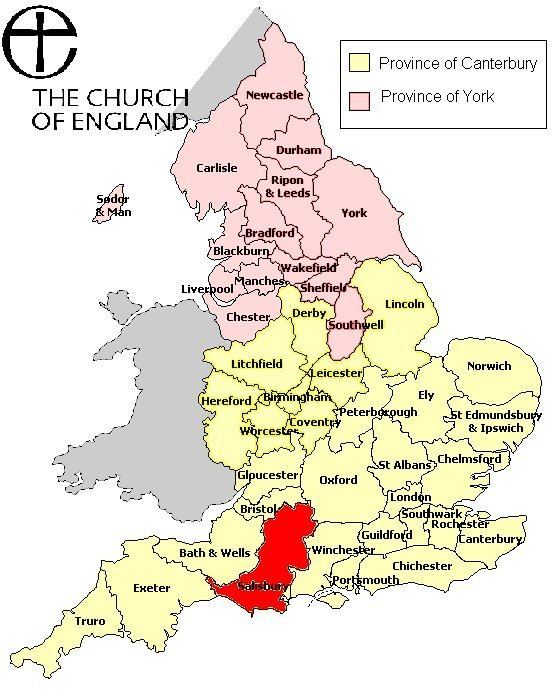Ecclesiastical province Canterbury Churches 582 Phone +44 1722 411922 Suffragans Ed Condry, Karen Gorham | Parishes 459 Cathedral Salisbury Cathedral Church 582 | |
 | ||
Archdeaconries Dorset, Sarum, Sherborne, Wilts Bishop Nick Holtam, Bishop of Salisbury Archdeacons Alan Jeans, Archdeacon of Sarum
Paul Taylor, Archdeacon of Sherborne
Antony MacRow-Wood, Archdeacon of Dorset
Sue Groom, Archdeacon of Wilts Address Church House, 99 Crane St, Salisbury SP1 2QB, UK Similar Salisbury Cathedral, Diocesan Education Centre, Old Sarum, St Mary and St Nicholas, The Diocese of Salisbury Profiles | ||
Canon ian woodward describes diocese of salisbury s relati
The Diocese of Salisbury is a Church of England diocese in the south of England, within the ecclesiastical Province of Canterbury. The diocese covers most of Dorset (excepting the deaneries of Bournemouth and Christchurch, which fall within the Diocese of Winchester), and most of Wiltshire (excepting a part in the north and Swindon). The diocese is led by the Bishop of Salisbury (Nick Holtam) and the diocesan synod. The bishop's seat is at Salisbury Cathedral.
Contents
- Canon ian woodward describes diocese of salisbury s relati
- Roman Catholic
- Anglican
- Bishops
- Archdeaconries and deaneries
- Sarum Use
- References
Roman Catholic
The Diocese of Sherborne (founded c. AD 705) was the origin of the present diocese; St Aldhelm was its first Bishop of Sherborne. The Diocese of Ramsbury was created from the northwestern territory of the Bishop of Winchester in 909.
Herman of Wilton, bishop of both Ramsbury and then Sherborne, obtained approval from Edward the Confessor to transfer his seat to Malmesbury, but this plan was blocked by the monks of Malmesbury Abbey and Earl Godwin. Instead, following the Norman conquest, the 1075 Council of London named him Bishop of Sarisberie (Latin: Seriberiensis episcopus), which had been made a royal stronghold by William I. This was at Old Sarum. Disputes between the bishops Herbert and Richard Poore and the sheriffs of Wiltshire led to the removal of the see in the 1220s to a new site on Salisbury Plain. This was chartered as the city of New Sarum by King Henry III in 1227, but it was not until the 14th century that the office was described (by Robert Wyvil) as the Bishop of Sarum (episcopus Sarum). The diocese, like the city it administers, is now known as Salisbury. The archdeaconry around Salisbury, however, retains the name of Sarum.
Anglican
Reforms within the Church of England led to the annexation of Dorset from the abolished diocese of Bristol in 1836; Berkshire, however, was removed the same year and given to Oxford.
In 1925 and 1974, new suffragan bishops were appointed to assist the Bishop of Salisbury; the new offices were titled the bishops of Sherborne and Ramsbury, respectively. Until 2009 the bishops operated under an episcopal area scheme established in 1981, with each suffragan bishop having a formal geographical area of responsibility, and being known as "area bishops". The Bishop of Ramsbury had oversight of the diocese's parishes in Wiltshire, while the Bishop of Sherborne had oversight of the diocese's parishes in Dorset. This scheme was replaced to reflect the increased working across the whole diocese by all three bishops. The two suffragans may now legally function anywhere in the diocese, and the Bishop of Salisbury may delegate any of his functions to them.
The diocese is also divided into four archdeaconries, two for each county. These are further subdivided into deaneries and parishes.
Bishops
The diocesan Bishop of Salisbury is assisted across the diocese by two suffragans – the Bishop of Sherborne and the Bishop of Ramsbury. The provincial episcopal visitor (since 1994, for parishes in this diocese – among twelve others in the western part of the Province of Canterbury – who reject the ministry of priests who are women) is Jonathan Goodall, Bishop suffragan of Ebbsfleet, who is licensed as an honorary assistant bishop of the diocese in order to facilitate his work there.
There are several former bishops licensed as honorary assistant bishops in the diocese:
Archdeaconries and deaneries
There are nineteen deaneries within the diocese.
Sarum Use
The Sarum Rite (more properly called Sarum Use) was a variant of the Roman Rite widely used for the ordering of Christian public worship, including the Mass and the Divine Office. It was established by Saint Osmund, Bishop of Salisbury in the 11th century and was originally the local form used in the Cathedral and Diocese of Salisbury; it later became prevalent throughout southern England and came to be used throughout most of England, Wales, Ireland and later Scotland until the reign of Queen Mary. Although abandoned after the 16th century, it was also a notable influence on the pattern of Anglican liturgy represented in the Book of Common Prayer. Occasional interest in and attempts at restoration of the liturgy by Anglicans and Roman Catholics have not produced a general revival, however.
